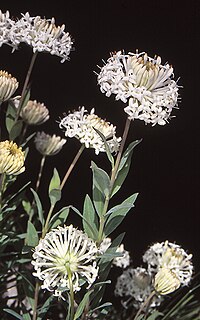
Pimelea spicata, commonly known as the spiked rice flower, is a flowering plant in the family Thymelaeaceae and is endemic to New South Wales. It is a slender plant with white flowers and elliptic leaves.

Olearia pimeleoides, commonly known as pimelea daisy-bush, is a species of flowering plant in the family Asteraceae and is endemic to southern continental Australia. It is an erect shrub with elliptic, linear or lance-shaped leaves, and white and pale yellow, daisy-like inflorescences.

Pimelea sericea is a species of shrub in the family Thymelaeaceae. It is native to Australia, specifically Tasmania. Their common name is mountain rice flower. Pimelea means fat and sericea means silk. The reason could be that Pimelea species usually have oily seeds and fleshy cotyledon. The sericea came from the fact that they are covered with silky hair.

Boronia forsteri is a plant in the citrus family Rutaceae and is endemic to mountain ranges in central Queensland, Australia. It is an erect shrub with many branches, simple leaves with a densely hairy, pale underside, and pink, four-petalled flowers.

Pimelea treyvaudii, commonly known as grey rice-flower, is a species of shrub in the family Thymelaeaceae. It has white flowers in spherical heads at the end of branches and is endemic to eastern Australia.

Pimelea ammocharis is a species of small shrub in the family Thymelaeaceae. It is a small shrub with white-yellow to orange flowers and is endemic to Western Australia.

Pimelea curviflora, also known as curved rice-flower is a shrub in the family Thymelaeaceae and is endemic to Australia. It is a small, hairy shrub with greenish-yellow or red tubular flowers.

Pimelea venosa, commonly known as Bolivia Hill rice-flower, is a flowering plant in the family Thymelaeaceae and is endemic to a restricted area of New South Wales. It is an erect shrub with densely long-hairy stems and leaves, elliptic to lance-shaped leaves and small groups of white flowers.
Hibbertia arnhemica is a species of flowering plant in the family Dilleniaceae and is endemic to Arnhem Land in the Northern Territory. It is an erect shrub with hairy branchlets, egg-shaped or elliptic leaves and spikes of eight to fifteen yellow flowers, each with twenty to thirty stamens arranged on one side of the two carpels.
Triplarina bancroftii is a species of flowering plant in the myrtle family, Myrtaceae and is endemic to a restricted area of Queensland. It is a shrub with egg-shaped or elliptic leaves, flowers with five sepals and five relatively small white petals and sixteen to eighteen stamens.
Hibbertia cymosa is a species of flowering plant in the family Dilleniaceae and is endemic to a restricted area of Queensland. It is a shrub with densely hairy foliage, elliptic leaves, and yellow flowers, each with fifty to eighty stamens arranged in bundles around three carpels.
Pultenaea borea is a species of flowering plant in the family Fabaceae and is endemic to Queensland, Australia. It is an erect shrub with elliptic to linear or egg-shaped leaves and yellow to orange and red flowers.
Hibbertia hendersonii is a species of flowering plant in the family Dilleniaceae and is endemic to the Blackdown Tableland in Queensland. It is an erect shrub with densely hairy foliage, narrow elliptic leaves, and yellow flowers, each usually with twenty to thirty-one stamens arranged on one side of the two carpels.
Hibbertia laurana is a species of flowering plant in the family Dilleniaceae and is endemic to far northern Queensland. It is a shrub with hairy foliage, elliptic leaves, and yellow flowers, each with thirty to fifty stamens arranged in rows on one side of the two hairy carpels.
Hibbertia mulligana is a species of flowering plant in the family Dilleniaceae and is endemic to north-eastern Queensland. It is a sub-shrub with narrow elliptic leaves and yellow flowers with 70 to 74 stamens arranged around three densely hairy carpels.
Olearia macdonnellensis is a species of flowering plant in the family Asteraceae and is endemic to a restricted part of the Northern Territory of Australia. It is an erect, bushy shrub shrub with broadly elliptic to broadly egg-shaped leaves and yellow, or white and yellow, daisy-like inflorescences.

Leucopogon cuspidatus is a species of flowering plant in the family Ericaceae and is endemic to the central Queensland coast. It is a shrub with densely hairy young branchlets, egg-shaped to lance-shaped leaves with the narrower end towards the base, and white, bell-shaped flowers that are bearded inside.

Pimelea altior is a species of flowering plant in the family Thymelaeaceae and is endemic to eastern Australia. It is a shrub with elliptic leaves and heads of white, tube-shaped flowers.

Pimelea amabilis is a species of flowering plant in the family Thymelaeaceae and is endemic to northern Queensland. It is a small shrub with narrowly elliptic or elliptic leaves and spikes of hairy, yellowy-green or yellow, tube-shaped flowers.
Pimelea aquilonia is a species of flowering plant in the family Thymelaeaceae and is endemic to far north Queensland. It is a shrub with narrowly elliptic leaves and small clusters of hairy, white or cream-coloured, tube-shaped flowers.










